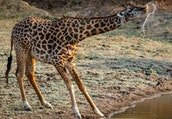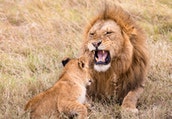- 1. Africa Greater Kudu Appearance: Greater Kudus are one of the largest antelope species, with males being larger than females. Males, known as bulls, can stand around 4.5 to 5.5 feet (1.4 to 1.7 meters) tall at the shoulder and weigh between 440 to 600 kilograms (970 to 1,320 pounds). Females, known as cows, are slightly smaller.
- 2. Africa Greater Coat and Markings: Greater Kudus have a striking coat with a mix of colors. Their coat is typically greyish-brown with white vertical stripes along their body. These stripes help them blend into their environment and provide camouflage. Both males and females have long, spiral-shaped horns that can grow up to 70 inches (1.8 meters) in length for bulls.
- 3. Africa Greater Kudu Habitat: Greater Kudus are found in a variety of habitats, including woodland, savanna, and bushland. They are most commonly seen in areas with dense vegetation, where they can find food and cover.
- 4. Africa Greater Kudu Diet: Greater Kudus are herbivores and primarily feed on leaves, grasses, fruits, and herbs. They are browsers, meaning they feed on leaves and twigs from bushes and trees, as opposed to grazers that primarily eat grass.
- 5. Africa Greater Kudu Behavior: Greater Kudus are mainly active during the early morning and late afternoon, resting during the heat of the day. They are generally shy and elusive, making them challenging to spot in the wild. When threatened, they are known to escape into dense vegetation.
- 6. Africa Greater Kudu Social Structure: Greater Kudus are typically solitary animals or found in small groups consisting of females and their offspring. Adult males are more solitary and territorial, especially during the breeding season.
- 7. Africa Greater Kudu Breeding and Reproduction: Breeding usually occurs throughout the year, with peak mating seasons varying in different regions. Male kudus engage in dominance displays and fights to establish mating rights with females.
- 6. Africa Greater Kudu Conservation Status: The Greater Kudu is listed as "Least Concern" by the International Union for Conservation of Nature (IUCN). Although they face some threats, such as habitat loss and hunting, they are still relatively widespread and have stable populations in many areas of Africa.
Africa Greater Kudu:
The Greater Kudu (Tragelaphus strepsiceros) is a large and majestic antelope species found in various parts of Africa. Greater Kudus are fascinating animals and a popular attraction for wildlife enthusiasts on safaris in Africa.
Africa Safari Tour Book online The Greater Kudu safari. To observe them in their natural habitat, it's best to visit national parks and reserves known for their diverse wildlife, such as Kruger National Park in South Africa, Serengeti National Park in Tanzania, and Etosha National Park in Namibia.
Here is some information about the Greater Kudu:
Africa Greater Kudu Safari
An Africa Greater Kudu safari is a thrilling experience for wildlife enthusiasts seeking to observe these majestic antelopes in their natural habitat. Here are some key points to consider when planning a safari with a focus on Greater Kudus:
Safari Destinations
Greater Kudus can be found in various countries across sub-Saharan Africa. Some of the best destinations for observing Greater Kudus include:
- South Africa: Kruger National Park, Hluhluwe-iMfolozi Park, and Addo Elephant National Park.
- Namibia: Etosha National Park, Waterberg Plateau Park, and Damaraland.
- Botswana: Chobe National Park and Moremi Game Reserve.
- Zimbabwe: Hwange National Park and Matobo National Park.
- Tanzania: Serengeti National Park, Ngorongoro Crater, and Selous Game Reserve.
- Kenya: Maasai Mara National Reserve and Amboseli National Park.
Wildlife Viewing:
A Greater Kudu safari offers the chance to observe these elusive antelopes in their natural environment. It's essential to be patient and keep a keen eye out for them, as they can be shy and blend into their surroundings.
Safari Activities
Participate in game drives or guided walking safaris with experienced trackers and guides. Game drives provide opportunities to cover more ground and access different areas of the national parks, while walking safaris offer a more intimate experience with the wildlife.
Accommodations
Choose safari lodges or tented camps located within or near the national parks for easy access to wildlife-rich areas. These accommodations offer comfortable amenities and often provide guided game drives and nature walks.
Wildlife Diversity
Wildlife Diversity: While on your Greater Kudu safari, you'll have the chance to encounter a wide range of African wildlife, including elephants, lions, zebras, giraffes, and many more species.
Conservation and Responsible Tourism
Conservation and Responsible Tourism: Embrace responsible tourism practices by following park regulations and respecting the natural behavior of wildlife, including Greater Kudus. Support conservation efforts that aim to protect their habitats and populations.
Photography Opportunities
Photography Opportunities: Bring a good camera with a zoom lens to capture the beauty of the Greater Kudus and the surrounding landscapes. A pair of binoculars will also be handy for better wildlife viewing.
Season and Weather
Season and Weather: Consider the best time to visit your chosen destination, as wildlife sightings and weather conditions can vary throughout the year. In some regions, the dry season may be better for wildlife viewing, while in others, the wet season might offer lush landscapes and baby animals.








 |
|  |
|  |
|  |
| 